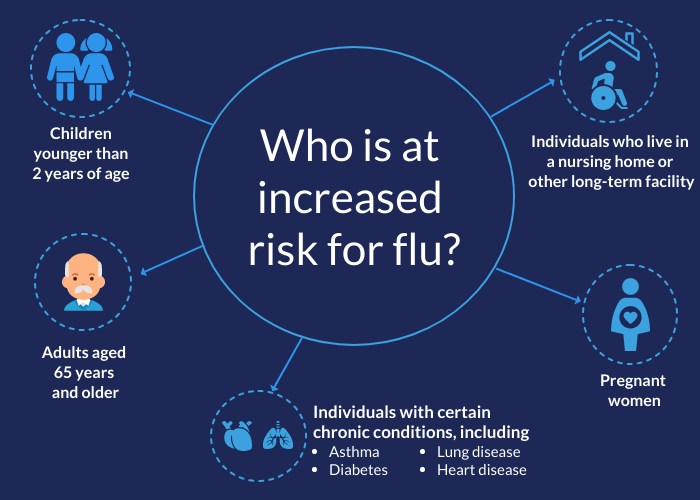Share Article
As we approach the end of the summer, it’s time to start looking ahead to colder weather and annual influenza (flu) season. Seasonal flu vaccination is set to begin in about four weeks—around mid-September. So while COVID-19 currently presents the most urgent threat of respiratory illness, it’s important that we are all protected against unnecessary exposure to the flu, another potentially deadly virus, especially for high-risk populations.
In the 2017-2018 and 2018-2019 flu seasons, the Maryland Department of Health reported over 4,300 emergency-room visits each year for influenza-like illness for patients aged 65 years and older. Among confirmed influenza cases, there were approximately 2,500 hospitalizations in 2017-2018 and 1,400 in 2018-2019. A 2018 study estimated that average annual direct medical costs are $3.2 billion nationwide, with more than 40% of the those costs attributed to patients aged 65 years and older.
At the peak of flu season, the Maryland Department of Health recorded nearly 500 flu-related hospitalizations in one week, and the majority of those hospitalized were adults aged 65 and older. According to the latest reports on COVID-19 cases, nearly 500 Marylanders are currently hospitalized with the coronavirus. In April, when COVID-19 cases surged in Maryland, more than 1,700 people were hospitalized in a single week. So a widespread and severe flu season on top of the pandemic could place undue strain on hospitals and long-term care facilities.
Patients aged 65 and older account for nearly $1.3 billion in annual, flu-related hospital costs.
Severe influenza can be devastating. It can worsen an individual’s existing chronic conditions, especially diabetes, heart disease, and chronic obstructive pulmonary disease (COPD); and it can cause deadly complications like pneumonia and respiratory failure.
The good news is that the flu and its associated complications are largely preventable with the annual flu vaccine. One study found that the flu vaccine can reduce hospitalizations among older adults by nearly 40%. For adults who are hospitalized for the flu even though they were vaccinated, they are less likely to be admitted to intensive care, have less severe disease, and have shorter hospital stays.
Unfortunately, estimated vaccination rates for Medicare beneficiaries are low: From 2006 to 2016, coverage ranged from 46% to 50% for all age-attributed Medicare beneficiaries.
Fewer than half all Medicare patients in the United States get their annual flu shot
In anticipation of influenza season and its potential to increase the burden on our health care system, reaching “normal” levels of vaccination is simply not sufficient. Efforts to promote flu vaccination at primary care practices and pharmacies must be intensified.
The CDC is urging individuals who are at high risk for severe flu—as well as COVID-19—to get the seasonal flu vaccine. The frequency of COVID-19 and flu co-infections is still unknown, but we do know that they are possible. Erring on the side of caution and assuming a high risk for co-infections highlights the need for an aggressive flu vaccine campaign this year.

While we face an immense number of unknowns in fighting COVID-19, seasonal flu is a familiar foe. We already have an effective vaccine program to prevent flu and reduce the potential complications that this virus can cause. Getting a flu vaccine protects each of us, prevents unnecessary medical visits and hospitalizations, and lessens the burden on our frontline health care workers.
If you, or a patient, are unsure where flu vaccines are available near you, please visit www.vaccinefinder.gov.
Netrin Health uses proprietary data analytics and algorithms to generate actionable insights that guide care management. Let us help you increase flu vaccination rates in your patients. Contact us today
Centers for Disease Control and Prevention, 2020. Frequently Asked Influenza (Flu) Questions: 2020-2021 Season. Accessed August 12, 2020.
Centers for Disease Control and Prevention, 2020. People at High Risk for Flu Complications. Accessed August 12, 2020.
Centers for Disease Control and Prevention, 2020. Similarities and Differences Between Flu and COVID-19. Accessed August 12, 2020.
Maryland Department of Health, 2020. Maryland COVID-19 Data Dashboard. Accessed August 12, 2020.
Maryland Department of Health, 2020. MDH FluWatch. Accessed August 12, 2020.
Putri, W., et al., 2018. Economic Burden of Seasonal Influenza in the United States. Vaccine, 36 (2018), 3960-3966. Accessed August 12, 2020.
Rondy, M., et al., 2017. Effectiveness of Influenza Vaccines in Preventing Severe Influenza Illness Among Adults: A Systematic Review and Meta-analysis of Test-negative Design Case-control Studies. Journal of Infection, 75(5), 381-394. Accessed August 12, 2020.
Shen, A., et al., 2018. Influenza Vaccination Coverage Estimates in the Fee-for Service Medicare Beneficiary Population 2006–2016: Using Population-based Administrative Data to Support a Geographic-Based Near Real-time Tool. Human Vaccines & Immunotherapeutics, 14(8), 1848-1852. Accessed August 12, 2020.
Thompson, M. G., et al. Influenza Vaccine Effectiveness in Preventing Influenza-associated Intensive Care Admissions And Attenuating Severe Disease Among Adults in New Zealand 2012–2015. Vaccine, 36(39), 5916-5925. Accessed August 12, 2020.
